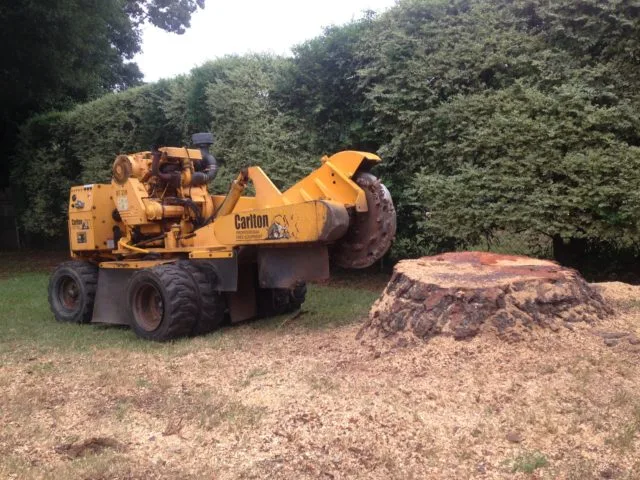Quick Answer: How Long and What to Expect in West Lake Hills
In West Lake Hills, grinding large tree roots usually takes 1–5 hours, depending on stump size, root spread, soil type, and access. Dense hardwoods like live oak and rocky limestone shelves push jobs toward the upper range. Pricing ranges from $300 to $1,200+ for extensive root work, with setup, safety prep, and cleanup adding 30–60 minutes.
A 2024 survey of 12 tree service companies in Travis County found that live oak root grinding averaged $9.25 per stump inch with additional root removal billed hourly.
“Large root jobs here aren’t just about raw horsepower — it’s about understanding the terrain,” says Luis Ramirez, ISA Certified Arborist in Austin, Texas. “The limestone shelf in West Lake Hills can wear a set of grinder teeth down in a single day.”
Why Large Tree Roots Are a Bigger Challenge in West Lake Hills
West Lake Hills combines mature hardwood species, shallow bedrock, and sloped lots — all of which make root grinding more complex.
- Live oak roots can extend 2–3 times the canopy width with dense, interlocking grain.
- Cedar elm roots run close to the surface, weaving through rock layers.
- Pecan roots grow deep, sometimes into limestone pockets.
The caliche and limestone base slows progress and can spark during grinding, requiring extra safety measures.
Signs It’s Time to Grind Large Roots
- Roots lifting sidewalks or cracking driveways
- Lawn mowers hitting exposed roots
- Trip hazards in high-traffic areas
- Roots blocking drainage paths
- Interference with replanting or hardscape installation
Example: A West Lake Hills homeowner needed grinding before building a stone patio — three live oak roots, each 8–12 inches thick, were traced over 14 feet from the stump.
How Large Root Grinding Differs from Standard Stump Removal
Large root grinding requires:
- Extended cutting area 3–6 feet beyond the stump
- Deeper cuts (12–16 inches) to prevent regrowth
- Multiple grinder positions to follow lateral roots
- Extra passes through hardwood and rock
According to Texas A&M Forest Service data, live oak wood density averages 55–60 lbs/ft³, nearly double that of softwoods like pine.
Step-by-Step Process for Grinding Large Roots in West Lake Hills
- Inspection & Utility Locate – Measure stump, identify species, map roots, call 811
- Access Planning – Account for narrow gates, steep driveways, and landscaped barriers
- Grinding Passes – Start shallow, then deepen passes, following root lines
- Rock & Debris Management – Remove limestone chunks by hand to protect teeth
- Cleanup & Backfill – Haul chips, rake, add topsoil or compost if replanting
Timeframes for Large Root Grinding
Small root systems (12–18″ stump): 1–2 hrs
Large live oak roots in rocky soil: 3–5 hrs
Slope or tight access: +30–60 min
Root Type | Species | Soil Type | Estimated Time
Medium pecan roots | Pecan | Clay loam | 1.5–2 hrs
Large oak roots | Live oak | Limestone | 3–5 hrs
Mixed root network | Cedar elm + oak | Clay/rock mix | 2–4 hrs
Cost Breakdown for Large Root Grinding in West Lake Hills
- Base stump rate: $5–$8 per inch diameter
- Root grinding add-on: $100–$400+ depending on spread
- Rocky terrain surcharge: +10–25%
- Restricted access surcharge: +15–20%
“A single large oak stump with roots under a driveway cost one client $1,450 because of the extra time cutting through rock,” notes Ramirez.
Best Equipment for Large Root Jobs
- 50–65 HP tracked grinders for hardwood and slopes
- Carbide-tipped teeth for limestone resistance
- Offset cutter wheels for reaching under patios or walls
Manufacturers like Vermeer and Bandit rate these grinders at 6–8 inches per minute in average conditions — but West Lake Hills limestone often cuts that rate in half.
West Lake Hills Terrain and Soil Considerations
- Limestone shelves can limit depth to 8–12 inches in some areas
- Clay-loam is heavy and sticky after rain, slowing cleanup
- Sloped yards require stabilizing outriggers and careful positioning
These factors make an on-site evaluation essential before quoting.
Safety and Property Protection
- Maintain at least 18 inches from foundations when grinding
- Hand-dig within 12 inches of irrigation lines
- Use tarps or shields to contain debris
- Observe local noise restrictions (often no work before 8 a.m.)
DIY vs Professional for Large Roots in West Lake Hills
Rental grinders (13–18 HP) often lack the power for dense hardwood in rock-heavy soil, taking 3–4 times longer than pro machines.
Professionals bring higher horsepower, knowledge of terrain, and skill in working near utilities and structures — making them more efficient and cost-effective.
Post-Grinding Options and Yard Recovery
- Backfill with compacted soil to prevent sinking
- Add compost or soil amendments before replanting
- Prep for patios, walkways, or garden beds
- Monitor for settling over the first month
FAQs
Can roots be ground without removing the stump?
Yes, but regrowth may occur if grinding is shallow.
How deep should large roots be ground in rocky soil?
Usually 8–12 inches, deeper where soil allows.
Do live oak roots grow back after grinding?
Possible if roots aren’t fully severed and ground below active tissue.
Is grinding safe next to retaining walls?
Yes, with reduced depth and controlled passes.
What Details to Share for an Accurate Estimate
- Stump diameter and species
- Root spread and visible length
- Access width and slope
- Soil type or rock presence
- Proximity to structures/utilities
- Photos from multiple angles
For a precise, local estimate, contact a licensed, insured, ISA-certified arborist familiar with West Lake Hills conditions. Providing detailed info upfront ensures accurate time and cost estimates.

